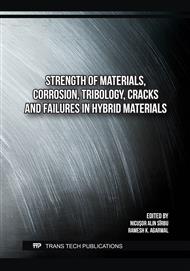p.3
p.9
p.15
p.21
p.27
p.35
p.45
p.55
An XFEM-Based Analysis on the Effect of Pre-Existing Cracks on the Woven GFRP with Central Side Edge Notch
Abstract:
Woven glass fibre-reinforced polymer composite materials are widely used in different sectors, replacing traditional construction materials with their advantages in lightweight construction, high strength-to-weight ratio, etc., and especially their ability to impart transverse stiffness to the structure. The objective of the current investigation is to introduce a side edge notch to the laminate and study the failure pattern. The effect of crack length on the failure pattern and strength of the laminate is also studied here using the extended Finite Element Method (XFEM). Maximum stress criteria based on bilinear traction separation law are utilised for crack initiation, and critical energy release criteria are used for crack opening and propagation. The results show the effectiveness of XFEM in capturing failure patterns in the laminate for all the considered cases.
Info:
Periodical:
Pages:
9-14
Citation:
Online since:
November 2025
Authors:
Price:
Сopyright:
© 2025 Trans Tech Publications Ltd. All Rights Reserved
Share:
Citation:


